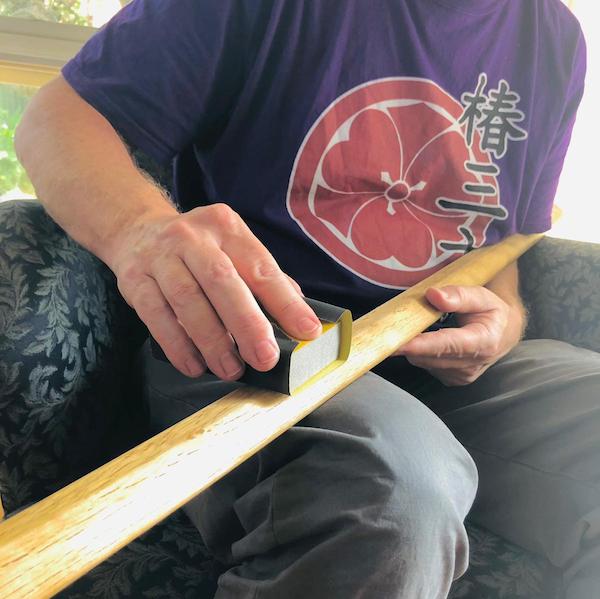
How to maintain your bokken, jō and tantō…
For an unvarnished new weapon or one that needs serious maintenance you can start with very fine grit (P400), then work your way successively through P600 up to super fine grit (P1200).
Wooden weapons are best maintained by regular sanding and oiling. A hard, smooth surface makes your weapon not only less likely to splinter or break but also aesthetically pleasing to handle and use in training.
There are three typical finishes for wooden weapons you buy: varnished, unvarnished and oil-polished.
Although varnish produces a tough coating, it can become sticky. It’s more difficult to slide the jō through your hand to execute a smooth tsuki. You can remove varnish using medium grit sandpaper (P80) to get back to bare wood.
To maintain oil-polished weapons use P600–1200 grit, depending on how much action the weapon has seen, then oil lightly.
Generally start with P400 paper to sand out cracks and dings and remove any loose fibers. Sand with even pressure back and forth along the length of the weapon, parallel to the grain of the wood and not across the grain.
Sanding
Bokken and tantō typically have flat spines with bevelled edges transitioning to the blade. Some have flat surfaces near the tip as well. Use a sanding block, keeping the sandpaper flat and parallel to the wood, to maintain the flat surfaces and crisp edges.
For curved surfaces, wrap the sandpaper around, matching the shape of the wood with your hand.
The jō is a cylinder with straight sides and flat ends at 90°. There is sometimes a small bevel on each end which you can preserve. This classic shape creates striking surfaces like small curved blades at each end of the jō. Take care not to round off or taper the ends.
Oiling
Japanese manufacturers recommend camellia oil, but most classic wood oils and many vegetable oils are fine. Avoid mineral oils. We’ll expand on this in a future blog.
Wipe off the sawdust. Apply oil gradually using a soft cloth until the surface remains slightly oily and slippery. Leave the weapon for at least an hour (even overnight) for the surface oil to be absorbed.
Oily sawdust will quickly clog your sandpaper, so wipe off excess oil or wait a bit longer for the oil to be absorbed before sanding again. If you’re in a rush, be persistent and sand until you start to produce dry sawdust.
Finishing
Repeat the sanding and oiling sequence with increasingly fine grit paper. The final coat of oil will be very light. Wipe off any residue and polish with an absorbent cloth.
The best way to judge your progress is by how smooth and dry the weapon feels. Continue until you’re satisfied with the finish: it should feel glossy smooth and hard but not dry.
You’ll probably never sand out every dent or ding from a weapon you train with, but remember that each mark was earned. It represents a strike or a deflection that protected part of your body.
